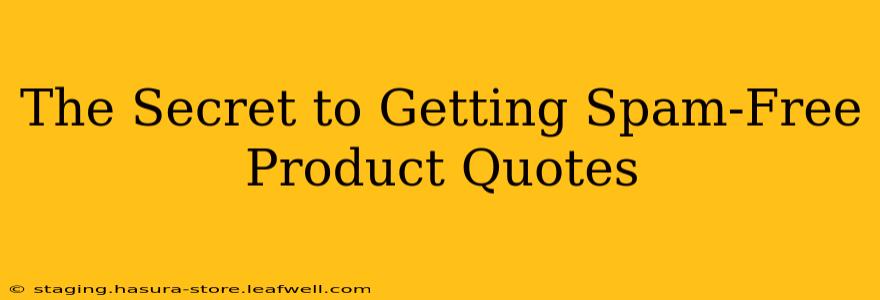Getting quotes for products can feel like wading through a swamp of unsolicited emails and sales calls. It's frustrating, time-consuming, and frankly, annoying. But there's a secret to navigating this process and securing the information you need without the deluge of spam. This isn't about avoiding all contact; it's about strategically managing it so you receive relevant information efficiently and respectfully.
Why Do I Get So Much Spam When Requesting Quotes?
Many businesses utilize quote request forms and email addresses as lead generation tools. They often sell these leads to other companies, resulting in an avalanche of unwanted contact. Additionally, some companies employ aggressive marketing tactics, regardless of your expressed needs. Understanding this underlying dynamic is the first step in controlling the flood.
How Can I Avoid Getting Spammed After Requesting a Quote?
This is where strategy comes in. Here's a breakdown of techniques to minimize unwanted communication while still receiving the quotes you need:
1. Use a Dedicated Email Address
Create a separate email address specifically for quote requests. This keeps your primary inbox clean and allows you to easily manage the influx of communication related to your purchasing decisions. You can even create filters to automatically sort these emails into a dedicated folder.
2. Be Specific and Concise in Your Requests
Vague requests attract generic responses and broader marketing campaigns. The more specific you are about your needs (product specifications, quantities, delivery dates, etc.), the more targeted and relevant the quotes you receive will be. Think of it like this: the more clearly you define your requirements, the less likely you are to be hit with irrelevant marketing material.
3. Research Companies Thoroughly Before Contacting Them
Do your homework! Check company reviews, testimonials, and online presence. Choose vendors with a reputation for professionalism and respectful communication. This preemptive screening significantly reduces the chances of encountering aggressive or spammy sales tactics.
4. Utilize Reputable Online Platforms
Platforms designed for business-to-business (B2B) communication often offer better control over lead generation and marketing practices. These platforms prioritize professionalism and often have features to manage communication preferences effectively.
5. Clearly State Your Communication Preferences
When submitting a quote request, explicitly state your preferred communication methods and frequency. For example, you could say, "Please only contact me via email if absolutely necessary, and no more than once per week." This sets clear boundaries and reduces the likelihood of excessive contact.
6. Use a Business-Oriented Approach
Approach the process professionally. Use a business email address, maintain a professional tone in your communication, and make it clear that you are serious about obtaining quotes. This helps establish your credibility and limits the chances of being targeted by less reputable companies.
What if I'm Already Receiving Spam?
If you're already overwhelmed with spam, here are some immediate actions you can take:
1. Unsubscribe
Unsubscribe from all unwanted email newsletters and promotional materials. Most emails have an unsubscribe link at the bottom.
2. Filter and Block
Utilize email filters to automatically move spam emails into a designated folder or delete them altogether. Block senders who repeatedly send unwanted messages.
3. Report as Spam
Mark unwanted emails as spam. This helps your email provider better identify and filter out future spam.
Conclusion: Take Control of Your Quote Requests
Getting product quotes doesn't have to be a spam-filled nightmare. By implementing these strategies, you can regain control of your inbox and focus on the important task of selecting the right products and vendors for your needs. Remember, proactive communication and clear expectations are key to a smoother, more efficient quote-gathering process.

